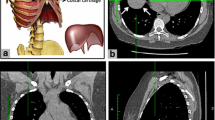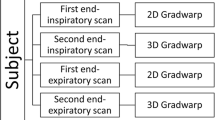Abstract
Purpose
The costal cartilage is a prominent feature of the anterior chest wall that is subject to developmental and acquired abnormalities. A fully automatic algorithm to reconstruct the human costal cartilage from multidetector computed tomography (MDCT) images was developed and tested.
Methods
The reconstruction algorithm includes three steps: (1) estimation of length, curvature and end points for each costal cartilage centre-line, (2) costal cartilage cross-section area approximation, and (3) transformation of the estimated cross-section to the centre-line into a cylindrical coordinate system. Four different models were as follows: circle, vertical ellipse, horizontal ellipse and a non-geometric shape have been assumed for the cross-section. Shape estimates were based on each patient’s dataset, so the algorithm is patient-specific and anatomically faithful. MDCT datasets from 15 patients were evaluated with the automated algorithm and the results compared with reference masks provided by an experienced radiologist.
Results
The costal cartilage reconstruction result and the reference mask were visually consistent. Based on evaluation results, the circular model cross-section with area of twice \(\mathbb {M}\) (mean area of all rib cross-sections in the mid-coronal plane) had the highest Dice similarity coefficient (\(\mathrm{DSC}=77.5\) %) with only 2.12 mm registration distance.
Conclusion
Costal cartilage 3D morphology can be extracted from MDCT scans with an automated method, using a circular cross-section with area equal to twice \(\mathbb {M}\).






Similar content being viewed by others
References
Bo T, Li J (2012) Preliminary analysis of thorax CT image pre-processing and 3D modeling of patients with pectus excavatum. Adv Mater Res 459:465–468
Boykov Y, Funka-Lea G (2006) Graph cuts and efficient ND image segmentation. Int J Comput Vis 70(2):109–131
Boykov Y, Jolly MP (2001) Interactive graph cuts for optimal boundary amp; region segmentation of objects in n-d images. In: Eighth IEEE international conference on computer vision, vol 1, no 1, pp 105–112
Boykov Y, Kolmogorov V (2004) An experimental comparison of min-cut/max-flow algorithms for energy minimization in vision. IEEE Trans Pattern Anal Mach Intell 26(9):1124–1137
Chang PY, Lai JY, Chen JC, Wang CJ (2007) Quantitative evaluation of bone and cartilage changes after the Ravitch thoracoplasty by multislice computed tomography with 3-dimensional reconstruction. J Thorac Cardiovasc Surg 134(5):1279–1283
Drake RL, Vogl W, Mitchell AWM (2009) Gray’s anatomy for students, 2nd edn. Churchill Livingstone, London
Forman Jl, Kent RW (2011) Modeling costal cartilage using local material properties with consideration for gross heterogeneities. J Biomech 44(5):910–916
Gray H (2008) Gray’s anatomy, 40th edn. Elsevier and Churchill Livingstone, London
Hastie T, Tibshirani R (1995) Generalized additive models for medical research. Stat Methods Med Res 4(3):187–196
Holbrook A, Pauly K (2007) Segmentation of costal cartilage in abdominal CT data using watershed markers, pp 226–231
Holcombe S, Ejima S, Huhdanpaa H, Jones A, Wang S (2008) Ribcage characterization for fe using automatic CT processing. In: 5th IEEE international symposium on biomedical imaging: from Nano to Macro, ISBI’05, pp 648–651
Kim H, Hwang J, Lim SY, Pyon JK, Mun GH, Bang SI, Choi SH, Oh K (2012) Preoperative rib cartilage imaging in 3-dimensional chest computed tomography for auricular reconstruction for microtia. Ann Plast Surg Reconstr Surg 72(4):1–7
Klinder T, Lorenz C, Berg J, Dries SPM, Blow T, Ostermann J (2007) Automated model-based rib cage segmentation and labeling in CT images. In: Ayache N, Ourselin S, Maeder A (eds) Medical image computing and computer-assisted intervention MICCAI 2007, lecture notes in computer science, vol 4792, pp 195–202. Springer, Berlin
Mohr M, Abrams E, Engel C, Long WBL, Bottlang M (2007) Geometry of human ribs pertinent to orthopedic chest-wall reconstruction. J Biomech 40(6):1310–1317
Moreira AHJ, Rodrigues PL, Fonseca J, Pinho ACM, Rodrigues NF, Correia-Pinto J, Vilaa JL (2012) Pectus excavatum postsurgical outcome based on preoperative soft body dynamics simulation. Medical imaging 2012: image-guided procedures, robotic interventions, and modeling, vol 8316, 83,160K–83,160K–8
Noorda Y, Bartels L, Pluim J (2012) Segmentation of the cartilage in the rib cage in 3D MRI. In: Yoshida H, Hawkes D, Vannier M (eds) Abdominal imaging. Computational and clinical applications, lecture notes in computer science, vol 7601, pp 229–237. Springer, Berlin
Pazokifard B, Sowmya A (2013) 3-d segmentation of human sternum in lung MDCT images. In: Engineering in medicine and biology society (EMBC), 2013 35th annual international conference of the IEEE, pp 3351–3354
Pazokifard B, Sowmya A (2014) Efficient graph-cuts based extraction of vertebral column and ribs in lung MDCT images. In: 2012 19th IEEE international conference on image processing (ICIP), pp 1182–1186
Pazokifard B, Sowmya A, Moses D (2014) Patient-customized 3d reconstruction of human ribs from lung MDCT dataset. In: IEEE 11th international symposium on biomedical imaging (ISBI), China, 29 April–2 May 2014 (accepted)
Sandoz B, Badina A, Laporte S, Lambot K, Mitton D, Skalli W (2013) Quantitative geometric analysis of rib, costal cartilage and sternum from childhood to teenagehood. Med Biolog Eng Comput 51(9):971–979
Shi H, Liu Q (2009) To generate a finite element model of human thorax using the VCH dataset
Stojkovic M, Milovanovic J, Vitkovic N, Trajanovic M, Grujovic N, Milivojevic V, Milisavljevic S, Mrvic S (2010) Reverse modeling and solid free-form fabrication of sternum implant. Australas Phys Eng Sci Med 33(3):243–250
Vaziri A, Nayeb-Hashemi H, Akhavan-Tafti B (2010) Computational model of rib movement and its application in studying the effects of age-related thoracic cage calcification on respiratory system. Comput Methods Biomech Biomed Eng 13(2):257–264
Wen-dong W, Yi-kai S, Huan W, Li-na Y (2009) Research on biomechanical model of children with pectus excavatum. In: 2nd international conference on biomedical engineering and informatics, 2009. BMEI ’09, pp 1–4
Conflict of interest
All authors declare that they have no conflict of interest in our research.
Author information
Authors and Affiliations
Corresponding author
Rights and permissions
About this article
Cite this article
Pazokifard, B., Sowmya, A. & Moses, D. Automatic patient-customised 3D reconstruction of human costal cartilage from lung MDCT dataset. Int J CARS 10, 465–472 (2015). https://doi.org/10.1007/s11548-014-1086-9
Received:
Accepted:
Published:
Issue Date:
DOI: https://doi.org/10.1007/s11548-014-1086-9




